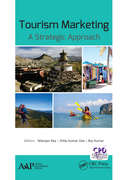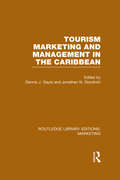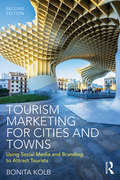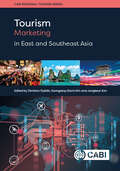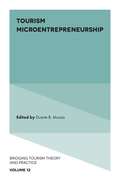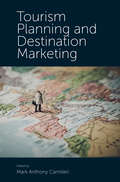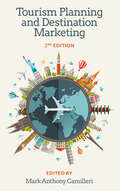- Table View
- List View
Tourism Marketing: In the Age of the Consumer
by Alastair M. MorrisonTourism Marketing: In the Age of the Consumer offers a fresh and contemporary approach as an introductory textbook on tourism marketing. Six major themes along with the traditional core marketing principles are blended together: Age of the consumer: This book places the customer at the heart of tourism marketing and not the sector’s promotional apparatus. Experiences: It highlights the growing consumer interest in the enjoyment of experiences and experiential marketing. New media: Social media and e-marketing are given emphasis throughout. Coverage of new media is present in all chapters. Global marketplace: Every chapter adopts a global outlook and offers international perspectives. Environment and social responsibility: An emphasis is placed on the sustainability of tourism, including the concepts of ethical tourism and social responsibility. Events: This book treats events as a major tourism marketing topic and integrates events within the concept of experiential marketing. Written in an engaging and accessible style, Tourism Marketing: In the Age of the Consumer is richly illustrated and full of actual case studies and examples looking at a wide variety of topics such as slum tourism, the sharing economy, staycations, event bidding, coping with COVID-19, air travel emissions and many more. Four features add interest and bring greater pedagogical value – Quick Bytes, Case Studies, Industry Voices and Vignettes. This will be essential reading for all tourism marketing students.
Tourism Marketing: In the Age of the Consumer
by Alastair M. MorrisonTourism Marketing: In the Age of the Consumer offers a fresh and contemporary approach as an introductory textbook on tourism marketing. Six major themes along with the traditional core marketing principles are blended together: Age of the consumer: This book places the customer at the heart of tourism marketing and not the sector’s promotional apparatus. Experiences: It highlights the growing consumer interest in the enjoyment of experiences and experiential marketing. New media: Social media and e-marketing are given emphasis throughout. Coverage of new media is present in all chapters. Global marketplace: Every chapter adopts a global outlook and offers international perspectives. Environment and social responsibility: An emphasis is placed on the sustainability of tourism, including the concepts of ethical tourism and social responsibility. Events: This book treats events as a major tourism marketing topic and integrates events within the concept of experiential marketing. Written in an engaging and accessible style, Tourism Marketing: In the Age of the Consumer is richly illustrated and full of actual case studies and examples looking at a wide variety of topics such as slum tourism, the sharing economy, staycations, event bidding, coping with COVID-19, air travel emissions and many more. Four features add interest and bring greater pedagogical value – Quick Bytes, Case Studies, Industry Voices and Vignettes. This will be essential reading for all tourism marketing students.
Tourism Marketing: A Strategic Approach
by Ray Nilanjan Das Dillip Kumar Kumar RajTourism Marketing: A Strategic Approach presents a variety of practical application tools, skills, practices, models, approaches, and strategies that are proving themselves effective in tourism marketing. The volume considers overall infrastructure, socioeconomic conditions, and modern tourism business infrastructure in discussing the efficiency of good strategies and practices and their impact on business and economic growth. Tourism is one of the fastest growing industries, and in the next few decades, it will play a role in many fields, such human resources, national economic growth, and more.
Tourism Marketing: A Strategic Approach
by Nilanjan Ray Dilip Kumar Das Raj KumarTourism Marketing: A Strategic Approach presents a variety of practical application tools, skills, practices, models, approaches, and strategies that are proving themselves effective in tourism marketing. The volume considers overall infrastructure, socioeconomic conditions, and modern tourism business infrastructure in discussing the efficiency of good strategies and practices and their impact on business and economic growth. Tourism is one of the fastest growing industries, and in the next few decades, it will play a role in many fields, such human resources, national economic growth, and more.
Tourism Marketing and Management in the Caribbean (Routledge Library Editions: Marketing)
by Dennis J. Gayle Jonathan N. GoodrichThe Caribbean now has one of the largest regional tourism industries in the world amongst developing countries. When originally published this volume was the first to provide a comprehensive discussion of tourism in this part of the world. It begins with an overview of the industry and then examines aspect of tourism marketing and management on a region-by-region basis, covering the Bahamas, Jamaica, Barbados, St Lucia, Trinidad and Tobago, Guyana and Cuba. Detailed analysis follows of sectors within the industry, such as heritage and health care, with central issues such as the intense competition between the cruise ship and hotel industries being highlighted. Discussion of the impact of US and EU policies on Caribbean tourism provides an important international perspective. Throughout, the focus is on the contribution of the regional tourism industry to Caribbean economic growth and development.
Tourism Marketing and Management in the Caribbean (Routledge Library Editions: Marketing)
by Dennis J. Gayle Jonathan N. GoodrichThe Caribbean now has one of the largest regional tourism industries in the world amongst developing countries. When originally published this volume was the first to provide a comprehensive discussion of tourism in this part of the world. It begins with an overview of the industry and then examines aspect of tourism marketing and management on a region-by-region basis, covering the Bahamas, Jamaica, Barbados, St Lucia, Trinidad and Tobago, Guyana and Cuba. Detailed analysis follows of sectors within the industry, such as heritage and health care, with central issues such as the intense competition between the cruise ship and hotel industries being highlighted. Discussion of the impact of US and EU policies on Caribbean tourism provides an important international perspective. Throughout, the focus is on the contribution of the regional tourism industry to Caribbean economic growth and development.
Tourism Marketing for Cities and Towns: Using Social Media and Branding to Attract Tourists
by Bonita KolbUnderstanding how places, particularly cities and towns, are marketed to and consumed by tourists, is vital to anyone working in the tourism industry. By creating and promoting a unique branded destination, the successful marketer can attract new visitors to their city or tourism attraction. With the rise of social media, there is even more scope to explore how tourism marketers can use their own and other social media sites to communicate with today’s tech connected traveler. In a new updated volume, Tourism Marketing for Cities and Towns provides thorough and succinct coverage of place marketing theory specific to the tourism industry. It focuses on clearly explaining how to develop the branded destination with special emphasis on product analysis, promoting authenticity and, new to this edition, the use of social media to create the personalized experiences desired by visitors. In addition, it contains a wide range of international examples and perspectives from a large variety of different stakeholders, alongside discussion questions and strategic planning worksheets. This book provides both practical advice with real-world application and a theoretical background to the field as a whole. Written in an engaging style, this book will be valuable reading for upper level students and business practitioners of Tourism, Marketing, Urban Studies, Business Management and Leisure Studies.
Tourism Marketing for Cities and Towns: Using Social Media and Branding to Attract Tourists
by Bonita KolbUnderstanding how places, particularly cities and towns, are marketed to and consumed by tourists, is vital to anyone working in the tourism industry. By creating and promoting a unique branded destination, the successful marketer can attract new visitors to their city or tourism attraction. With the rise of social media, there is even more scope to explore how tourism marketers can use their own and other social media sites to communicate with today’s tech connected traveler. In a new updated volume, Tourism Marketing for Cities and Towns provides thorough and succinct coverage of place marketing theory specific to the tourism industry. It focuses on clearly explaining how to develop the branded destination with special emphasis on product analysis, promoting authenticity and, new to this edition, the use of social media to create the personalized experiences desired by visitors. In addition, it contains a wide range of international examples and perspectives from a large variety of different stakeholders, alongside discussion questions and strategic planning worksheets. This book provides both practical advice with real-world application and a theoretical background to the field as a whole. Written in an engaging style, this book will be valuable reading for upper level students and business practitioners of Tourism, Marketing, Urban Studies, Business Management and Leisure Studies.
Tourism Marketing for Developing Countries: Battling Stereotypes and Crises in Asia, Africa and the Middle East
by Eli Avraham Eran KetterTourism Marketing for Developing Countries examines media strategies used by destinations in Asia, the Middle East and Africa to battle stereotypes, negative images and crises in order to attract tourists .
Tourism Marketing in East and Southeast Asia (CABI Regional Tourism Series)
by Catherine Cheung Ja Young Choe Chiara Di Blasio Rami K. Isaac Jia Ying Jiang Erdogan Koc Rob Law Hiu Yan Lee Kevin Yin Leung Nguyen Bao Linh Felix Elvis Otoo Fajar Kusnadi Putra Soo Yun Song Paul Strickland Maren ViolDespite the increased research interest in tourism in Asia, most research has focused on the key destinations (China, Macau, Hong Kong, Thailand), while neglecting other destinations which are less well explored. Little is known about the marketing efforts and practices, along with the successes and challenges, countries in the East and Southeast Asia have been experiencing. This book aims to address this oversight by exploring the marketing approaches, techniques and tools used by various countries in the region both collectively and individually to manage their tourism offerings and position them in the global tourism market: China, Hong Kong, Indonesia, Japan, Korea, Macau, Mongolia, Myanmar, Vietnam. It offers a contemporary and insightful look at the various case studies in East and Southeast Asia using inter-disciplinary perspectives and a range of methodological approaches and tools. The book: · Provides case studies developed by tourism researchers who are experts in their researched context countries; · Focuses on several countries at different stage of development; · Explores specific marketing strategies in East and Southeast Asian destinations, considering global trends and forces to fully understand the marketing environment. The book will be of interest to tourism marketing researchers, practitioners, academics, undergraduate and postgraduate students who will find these insightful contemporary case studies useful in the classroom.
Tourism Marketing in Western Europe (CABI Regional Tourism Series)
by Dr Konstantinos Andriotis Dimitrios Stylidis Jordi Arcos-Pumarola Jesús Barreal Pernas Thomas Bausch Bernardo Borges Francesco Calza Jacey Choe Marta Conill-Tetuà Elisabeth Cooper Rui Augusto Costa Mengyun Hu Elitza Iordanova Gil Jannes Eleonora Pantano Carina Ren Michele Simoni Annarita Sorrentino Dr Nikolaos Stylos Mariapina Trunfio Ilma Aulia ZaimTourism is characterized by diversity, enormous growth, and multidimensional impacts on several levels. In the current turbulent environment, tourism destinations need, on the one hand to maintain and enhance their products in the tourism map, and on the other hand, to protect their resources' integrity for future generations, based on sustainability premises. This is more evident for traditional destinations in Western-Europe, as many of them face the consequences of over-growth, unsustainable development, and lack of service quality. In this respect, attention in the literature needs to be given to how destinations in the region can conceptualize and mitigate their weaknesses as well as capitalize on their competences in order to plan, develop and manage tourism products that could lead them to sustainable competitiveness in the long-term. The collection of cases in this book: · Considers global trends and forces in order to understand the marketing environment of a wide number of countries and the appreciation of the sustainable competitive development of destinations. · Explores specific marketing strategies in Western-European countries' destinations. · Is authored by scholars who have performed extensive research on tourism in the countries documented. The book is of significant interest to those researching and working within the area of tourism marketing, but also of interest to students who are seeking wider reading on the topic.
Tourism-Marketing Performance Metrics and Usefulness Auditing of Destination Websites (Advances in Culture, Tourism and Hospitality Research #4)
by Arch G. WoodsideThis volume provides specific answers to hard questions about how to create valid metrics to measure the effectiveness of tourism advertising and the usefulness of destination marketing websites. An extensive literature review describes 40+ years of research on the effectiveness of tourism advertising and the slow advancement to using valid impact metrics - field experiments with alternative ad treatment and placements. Several authors undertake information-usefulness audits on DMO (destination management office) websites and provide practical check lists. Tourism website comparisons include: Maine, Massachusetts and New York; Genoa, Marseilles and Valencia; France, Spain and Portugal; and China, Poland, Russia and Thailand, against each other as well as the Lonely Planet websites. Content analysis of consumer-generated advertisements that promote visits to third places, in this case Starbucks coffee shops and Chipotle restaurants, makes an intriguing study. The final paper gives a thick description of the dynamics of the government's role in shaping China's domestic, inbound, and outbound tourism industry and contributes to building a behavioral theory of government-firm relationships.
Tourism Microentrepreneurship (Bridging Tourism Theory and Practice #12)
by Duarte B. MoraisTourism microentrepreneurship is defined as the process of launching a new, or adding value to an existing, enterprise with no more than five employees, providing tourism experiences, food, lodging or transportation, with the aim to support the owner’s livelihood and desired lifestyle. Volume 12 of Bridging Tourism Theory and Practice provides an overview of emerging scholarship and best practices on the development and integration of tourism microentrepreneurship in destination stewardship. Tourists have been breaking out of staged tourism enclaves for many decades, but only recently have information technologies empowered: a) tourists with information about destinations and supply, and b) entrepreneurial hosts with marketplaces. Tourism microentrepreneurs’ business activity is often informal and fluid, therefore, they have only recently become a visible and increasingly influential stakeholder group. As a result, they are not yet well studied, and practitioners struggle to support and integrate them into destination stewardship. Nevertheless, emerging evidence suggests that fuelling tourism microentrepreneurship and its integration in destination systems can generate added benefits to the host populations while making the destination more competitive and unique. Conversely, there is evidence that when left unbridled, tourism microentrepreneurship can erode the local character of neighborhoods and hurt the image of an entire destination. Tourism Microentrepreneurship shares scholarship and best practices to educate practitioners and to encourage more research on the development of microentrepreneurship and its impact on destination communities.
Tourism Microentrepreneurship (Bridging Tourism Theory and Practice #12)
by Duarte B. MoraisTourism microentrepreneurship is defined as the process of launching a new, or adding value to an existing, enterprise with no more than five employees, providing tourism experiences, food, lodging or transportation, with the aim to support the owner’s livelihood and desired lifestyle. Volume 12 of Bridging Tourism Theory and Practice provides an overview of emerging scholarship and best practices on the development and integration of tourism microentrepreneurship in destination stewardship. Tourists have been breaking out of staged tourism enclaves for many decades, but only recently have information technologies empowered: a) tourists with information about destinations and supply, and b) entrepreneurial hosts with marketplaces. Tourism microentrepreneurs’ business activity is often informal and fluid, therefore, they have only recently become a visible and increasingly influential stakeholder group. As a result, they are not yet well studied, and practitioners struggle to support and integrate them into destination stewardship. Nevertheless, emerging evidence suggests that fuelling tourism microentrepreneurship and its integration in destination systems can generate added benefits to the host populations while making the destination more competitive and unique. Conversely, there is evidence that when left unbridled, tourism microentrepreneurship can erode the local character of neighborhoods and hurt the image of an entire destination. Tourism Microentrepreneurship shares scholarship and best practices to educate practitioners and to encourage more research on the development of microentrepreneurship and its impact on destination communities.
Tourism, Mobilities, and Development in Sparsely Populated Areas
by Doris Carson Dean Carson Linda LundmarkTourism ‘mobilities’ are not restricted to the movement of tourists between places of origin and destinations. Particularly in more peripheral, remote, or sparsely populated destinations, workers and residents are also likely to be frequently moving between locations. Such destinations attract seasonal or temporary residents, sometimes with only loose ties to the tourism industry. These flows of mobile populations are accompanied by flows of other resources – money, knowledge, ideas and innovations – which can be used to help the economic and social development of the destination. This book examines key aspects of the human mobilities associated with tourism in sparsely populated areas, and investigates how new mobility patterns inspired by technological, economic, political, and social change provide both opportunities and risks for those areas. Examples are drawn from the northern peripheries of Europe and the north of Australia, and the book provides a framework for continuing research into the role that tourism and ‘new mobilities’ can play in regional development in these locations.This book was originally published as a special issue of the Scandinavian Journal of Hospitality and Tourism.
Tourism, Mobilities, and Development in Sparsely Populated Areas
by Doris A. Carson, Dean B. Carson and Linda LundmarkTourism ‘mobilities’ are not restricted to the movement of tourists between places of origin and destinations. Particularly in more peripheral, remote, or sparsely populated destinations, workers and residents are also likely to be frequently moving between locations. Such destinations attract seasonal or temporary residents, sometimes with only loose ties to the tourism industry. These flows of mobile populations are accompanied by flows of other resources – money, knowledge, ideas and innovations – which can be used to help the economic and social development of the destination. This book examines key aspects of the human mobilities associated with tourism in sparsely populated areas, and investigates how new mobility patterns inspired by technological, economic, political, and social change provide both opportunities and risks for those areas. Examples are drawn from the northern peripheries of Europe and the north of Australia, and the book provides a framework for continuing research into the role that tourism and ‘new mobilities’ can play in regional development in these locations.This book was originally published as a special issue of the Scandinavian Journal of Hospitality and Tourism.
Tourism, Performance, and Place: A Geographic Perspective (New Directions in Tourism Analysis)
by Jillian M. Rickly-Boyd Daniel C. Knudsen Lisa C. BravermanDrawing upon theories of landscape and performance, this work weaves together existing tourism literature with new scholarship to forge a geographically informed theory of tourism. Such a theory integrates the ways in which places are co-produced, circulated, interpreted, experienced, and performed for and by tourists, tourism boards, and even as everyday spaces. Bringing together theories of ritual, Peircean semiotics, ideology, and performance, the authors blend the often separate literatures of tourism sites and touristic practices. Whereas most tourism texts focus on a part of the 'tourism equation'-the tourism site, or the tourist experience-a geographic theory of tourism brings these constituent parts together in thinking about notions of place. Place processes are central to geography as well as tourism studies because tourism facilitates encounters with distinct locations. As this book argues, considering tourism as performative draws disparate areas of tourism theory together to better understand the ways tourism happens in and across places.
Tourism, Performance, and Place: A Geographic Perspective (New Directions in Tourism Analysis)
by Jillian M. Rickly-Boyd Daniel C. Knudsen Lisa C. BravermanDrawing upon theories of landscape and performance, this work weaves together existing tourism literature with new scholarship to forge a geographically informed theory of tourism. Such a theory integrates the ways in which places are co-produced, circulated, interpreted, experienced, and performed for and by tourists, tourism boards, and even as everyday spaces. Bringing together theories of ritual, Peircean semiotics, ideology, and performance, the authors blend the often separate literatures of tourism sites and touristic practices. Whereas most tourism texts focus on a part of the 'tourism equation'-the tourism site, or the tourist experience-a geographic theory of tourism brings these constituent parts together in thinking about notions of place. Place processes are central to geography as well as tourism studies because tourism facilitates encounters with distinct locations. As this book argues, considering tourism as performative draws disparate areas of tourism theory together to better understand the ways tourism happens in and across places.
Tourism, Philanthropy and School Tours in Zimbabwe: Problematising “Win-Win” Discourses (Routledge Insights in Tourism Series)
by Kathleen SmithersThis book explores the phenomena of school tours and tourism. It explores tensions of authenticity and artificiality in the school site being both a place of community learning and a spectacle for tourism consumption.Through the example of a school in Matabeleland North, Zimbabwe, the book examines the act of a school tour, whose main aim is to providing fund for the school. It offers a unique interdisciplinary lens that examines both the school as a tourism destination and as a site of learning. By drawing on these two fields, the book provides insights into the tensions inherent in a school that is also a tourism destination. This book will demonstrate to readers the tensions present in tourism partnerships with schools that include some source of philanthropic funding and unpack the complexities of tourism that draws on stereotypical cultural images. It explores these tensions through the lens of school leaders, students, teachers, and tourism personnel.The book provides a major and unique contribution to the field of tourism studies and education. It will be of interest to students and researchers interested in tourism studies, sociology, education, philanthropy, development studies, and the Global South.
Tourism, Philanthropy and School Tours in Zimbabwe: Problematising “Win-Win” Discourses (Routledge Insights in Tourism Series)
by Kathleen SmithersThis book explores the phenomena of school tours and tourism. It explores tensions of authenticity and artificiality in the school site being both a place of community learning and a spectacle for tourism consumption.Through the example of a school in Matabeleland North, Zimbabwe, the book examines the act of a school tour, whose main aim is to providing fund for the school. It offers a unique interdisciplinary lens that examines both the school as a tourism destination and as a site of learning. By drawing on these two fields, the book provides insights into the tensions inherent in a school that is also a tourism destination. This book will demonstrate to readers the tensions present in tourism partnerships with schools that include some source of philanthropic funding and unpack the complexities of tourism that draws on stereotypical cultural images. It explores these tensions through the lens of school leaders, students, teachers, and tourism personnel.The book provides a major and unique contribution to the field of tourism studies and education. It will be of interest to students and researchers interested in tourism studies, sociology, education, philanthropy, development studies, and the Global South.
Tourism, Pilgrimage and Intercultural Dialogue: Interpreting Sacred Stories (CABI Religious Tourism and Pilgrimage Series)
by Vitor Ambrósio David Carrillo-Rangel Thomas Coomans Tomasz Duda Tariq El Hadary Gabriel Ensenyat Joan Ferrer Costa Roger Ferrer Ventosa Blanca Garí Josep Gordi Lilian Grootswagers Maia Kanaan-Amat Josep M. Mallarach Tamara Ognejvic Dr Daniel H Olsen Elena Paschinger Marc SuredaReligious heritage and sacred sites offer an opportunity to visitors to explore the knowledge of the community visited, however the importance of interpretation, meaning, experience, and narrative need to be considered. This book is a timely re-assessment of the increasing linkages and interconnections between management of diversity and religious tourism and secular spaces on a global stage. It explores key learning points from a range of contemporary case studies of religious and pilgrimage activity, related to ancient, sacred and emerging tourist destinations and new forms of pilgrimage, faith systems and quasi-religious activities. By providing a conceptual framework the book demonstrates the symbolism of sacred spaces within religious traditions and the relations developed amongst them. It offers explanations on how to manage and how to communicate the religious diversity and provides a solid overview of: Religious tourism as a tool for intercultural dialogue Interpretation of religious heritage for tourism Cross-cultural contacts The book will provide a valuable resource for those researching and practicing in tourism management, pilgrimage and religious tourism.
Tourism Planning and Destination Marketing
by Mark Anthony CamilleriDestination marketing relies on planning, organisation, and successful strategies and tactics. Tourism Planning and Destination Marketing provides an in-depth understanding of the tourism marketing environment, including destination branding, distribution channels, etourism, digital media, and sustainable and responsible tourism practices. It is a useful guide for tourism marketers, including destination management organisations (DMOs), who are increasingly using innovative tools and evolving technologies to engage with prospective visitors. Moreover, this title sheds light on the latest developments in travel, hospitality, festivals and events, as the contributing authors have critically analysed the global tourism marketing environments that comprise a wide array of economic, socio-cultural, technological and environmental realities. This book explores advances in tourism planning and destination marketing theory for the interest of both researchers and scholars. Furthermore, it is an invaluable resource for a wide range of industry practitioners, including consultants, senior executives and managers who work for destination management organisations, tourism offices, hotels, inbound/outbound tour operators and travel agents.
Tourism Planning and Destination Marketing
by Mark Anthony CamilleriDestination marketing relies on planning, organisation, and successful strategies and tactics. Tourism Planning and Destination Marketing provides an in-depth understanding of the tourism marketing environment, including destination branding, distribution channels, etourism, digital media, and sustainable and responsible tourism practices. It is a useful guide for tourism marketers, including destination management organisations (DMOs), who are increasingly using innovative tools and evolving technologies to engage with prospective visitors. Moreover, this title sheds light on the latest developments in travel, hospitality, festivals and events, as the contributing authors have critically analysed the global tourism marketing environments that comprise a wide array of economic, socio-cultural, technological and environmental realities. This book explores advances in tourism planning and destination marketing theory for the interest of both researchers and scholars. Furthermore, it is an invaluable resource for a wide range of industry practitioners, including consultants, senior executives and managers who work for destination management organisations, tourism offices, hotels, inbound/outbound tour operators and travel agents.
Tourism Planning and Destination Marketing
by Mark Anthony CamilleriAuthored by more than 20 leading academics and providing in-depth coverage of a wide array of economic, social, technological and environmental realities in tourism planning and development, this volume is the latest in the field of travel and tourism. Contemporary topics are explored in-depth, including destination branding through cultural experiences; the planning and organisation of events; the promotion of the hospitality product, eco-tourism and sustainable practices; and the use of innovative tourism technologies such as digital media, augmented and virtual reality. The course content of this publication prepares undergraduate students and aspiring managers with a thorough exposure of the latest industry and research developments. Covering both theory and practice, it introduces its readers to contemporary tourism issues in a concise yet accessible way. This allows prospective tourism practitioners to critically analyse future situations and to make appropriate decisions in their workplace environments. Key terms are defined and clearly explained in the latter part of every chapter. This provides readers with a convenient source for learning and reviewing the tourism vocabulary that is required for effective communication on the job. Each chapter also contains a succinct summary that outlines its content in a condensed form, so as the readers could review and retain key information. Experiential exercises and case studies are provided to illustrate real situations that are meant to help aspiring managers in their future employment. Course conveners may use these cases as the basis of class discussions. In addition, web resources provide further information sources.
Tourism Planning and Destination Marketing
by Mark Anthony CamilleriAuthored by more than 20 leading academics and providing in-depth coverage of a wide array of economic, social, technological and environmental realities in tourism planning and development, this volume is the latest in the field of travel and tourism. Contemporary topics are explored in-depth, including destination branding through cultural experiences; the planning and organisation of events; the promotion of the hospitality product, eco-tourism and sustainable practices; and the use of innovative tourism technologies such as digital media, augmented and virtual reality. The course content of this publication prepares undergraduate students and aspiring managers with a thorough exposure of the latest industry and research developments. Covering both theory and practice, it introduces its readers to contemporary tourism issues in a concise yet accessible way. This allows prospective tourism practitioners to critically analyse future situations and to make appropriate decisions in their workplace environments. Key terms are defined and clearly explained in the latter part of every chapter. This provides readers with a convenient source for learning and reviewing the tourism vocabulary that is required for effective communication on the job. Each chapter also contains a succinct summary that outlines its content in a condensed form, so as the readers could review and retain key information. Experiential exercises and case studies are provided to illustrate real situations that are meant to help aspiring managers in their future employment. Course conveners may use these cases as the basis of class discussions. In addition, web resources provide further information sources.

